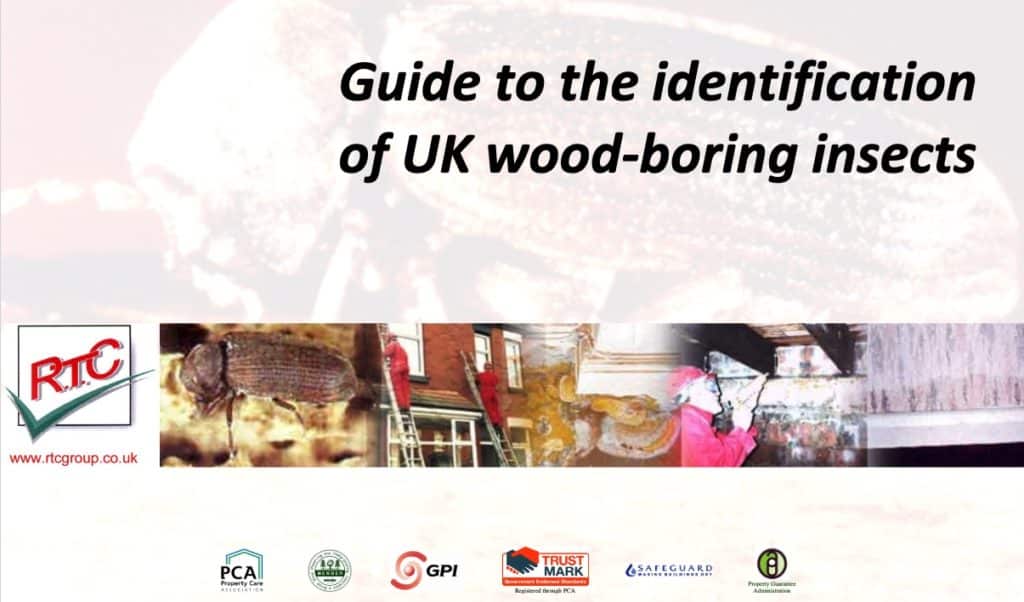Woodworm
What is woodworm?
The insects that trigger woodworm damage are beetles or weevils. They lay eggs in small cracks in your furniture, beams and floorboards.
What are the different types of woodworm?
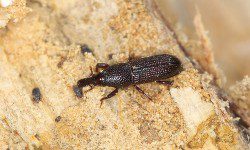
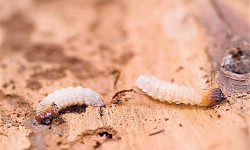
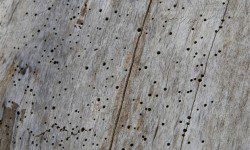
There are four main species of wood boring beetle affecting properties in the UK. These are the Common Furniture Beetle (Anobium Punctatum), Death Watch Beetle (Xestobium Rufovillosum), Wood Boring Weevil (Pentarthum Huttoni or Europhryum Confine) and the House Longhorn Beetle (Hylotrupes Bajulus), each preferring different sorts of timber.
The most common form of woodworm in the UK is the Common Furniture Beetle (Anobium Punctatum).
All woodworm eat timber in the larval stage of their lifecycle (between 3 -15 yrs, depending on species). They leave behind bore dust (frass) and, when they emerge to mate and die as an adult beetle, they leave behind an exit hole (size and shape vary according to species). The tunnels they form within the timber can weaken the timber, sometimes to a level where it can be structurally dangerous.
Our surveyors are fully qualified to identify which wood boring beetle is present, whether it is active or inactive and recommend the appropriate remedial treatment.
Our fully trained technicians will carry out the specialist work using only the safest professional insecticides.
These advanced chemicals are designed to be very safe to mammals (humans, pets etc.) but very effective against the insects causing the damage. In most cases, replacement of the timber is not necessary and, therefore, treatment is relatively inexpensive.
Types of woodworm beetle
Common Furniture beetle (Anobium Punctatum)
What does it look like?
- Small, dark, reddish
- 3mm – 5mm in length
- Regular lines running down its wings
Habitat
This common furniture beetle is by far the most common cause of damage encountered. Its speciality is sapwood of softwood and European hardwoods.
Signs of infestation
- Round holes, approximately 1.5 – 2mm in diameter
- Small piles of frass, seen within tunnels or on surfaces
- Frass will have a gritty texture
- Chocolate brown in colour
- 8mm in length
- Patches of yellowish hairs
- Round holes about 3mm in diameter
- Extensive tunnelling
- Lots of frass usually present; frass is ‘bun’ shaped and readily visible to the naked eye
- Woodboring Weevils attack both softwoods and hardwoods, which have previously been subject to decay
- Destruction is most commonly seen in damp skirting boards and embedded joist ends
- Tunnelling in sapwood tends to run along the grain
- Tunnels are narrow, around 1mm in diameter
- Frass is likely to be ‘sticky’ due to the dampness
- A mid reddish brown
- 8 – 9mm in length
- Flattened in shape
- Round holes 1.5 – 2mm
- Usually lots of flourlike frass – smooth when rubbed
- Live insects may be found around breakout holes
- Larger than most woodworm beetles at 15 – 20mm in length
- Black to dark brown
- Long antennae
- Grey hairs prominent on wing covers
- Oval emergence holes, 68mm across
- Severe internal damage, often filled with loose frass
- The surface of wood often remains thin and brittle when subject to a severe attack
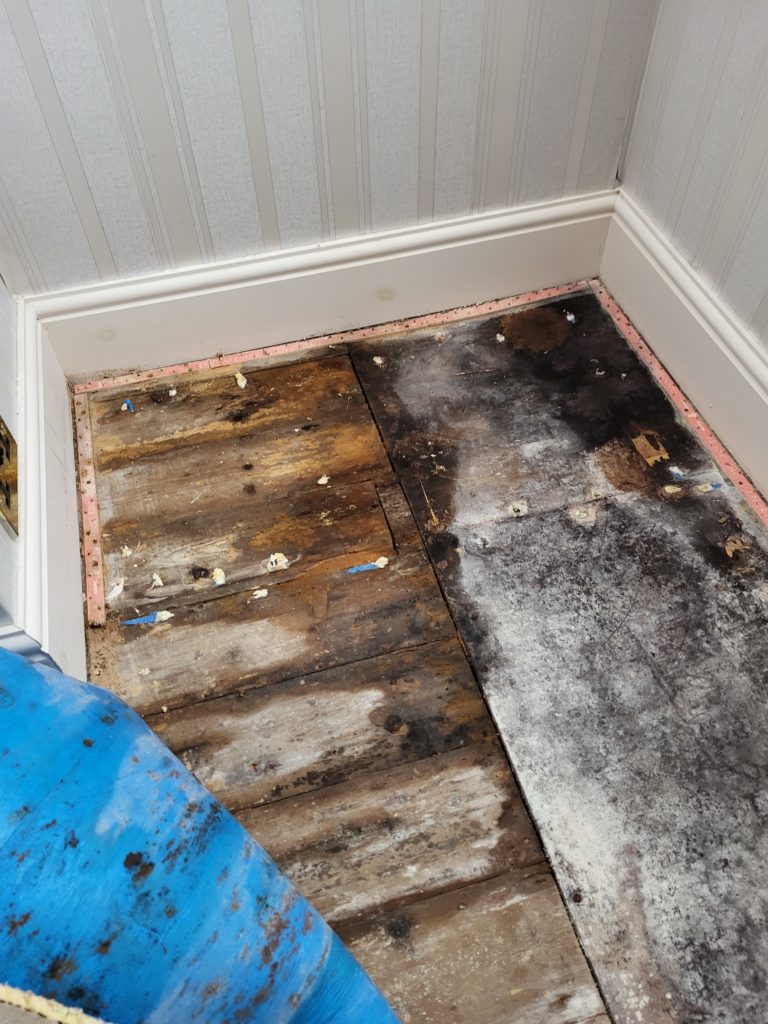
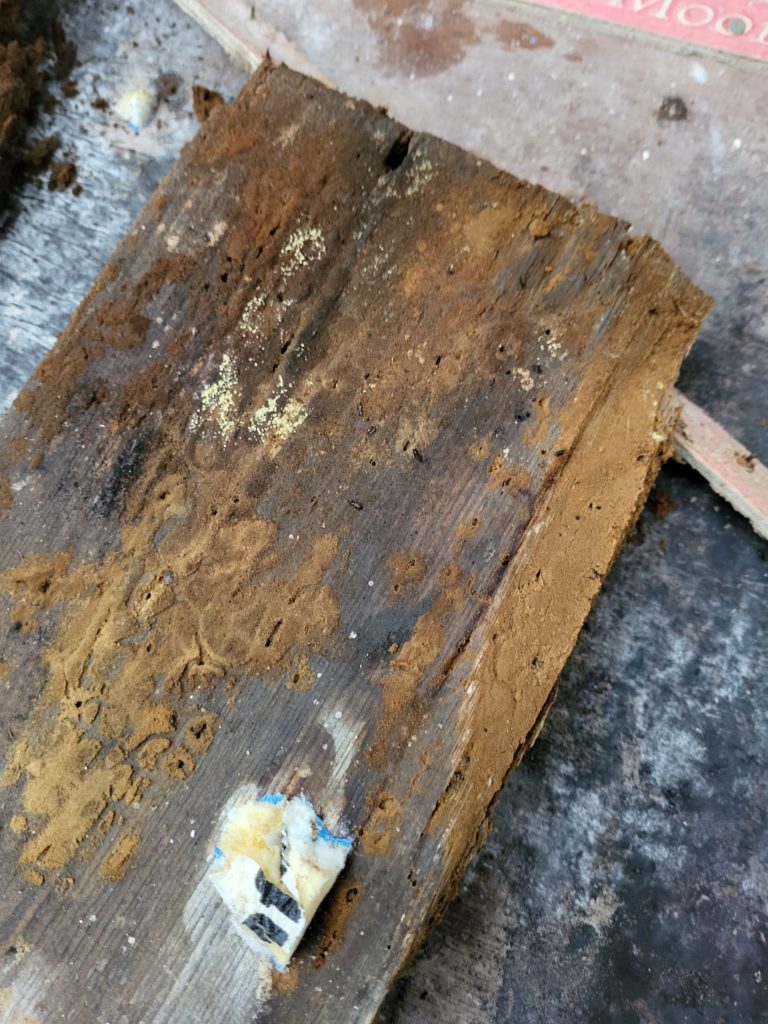
The lifecycle of woodworm
Woodworm insects are known to have between a two and five-year life cycle. Within this time, the larvae will hatch and then eat away the wood under the surface before re-emerging as beetles, mating, laying more eggs and then finally dying.
The life cycle of the wood-boring beetle is normally always near completion before most property owners are even aware they have a problem. Through understanding the details of the woodworms life cycle, we are able to treat the issue effectively and efficiently.
Stage 1
The beginning of the lifecycle sees the female worm/larvae lay its eggs in cracks, crevices and pre-existing holes in the timber created by previous woodworm. By doing this, the eggs remain safe and protected, allowing them to develop and eventually hatch.
Stage 2
After a few weeks, the eggs will hatch downwards and become, what we call ‘larvae’. Larvae is the term used for the woodworm of which now has between a three and five-year journey inside the wood/timber before it will ever see the light of day. The larvae are usually around 2mm in size. The larvae will begin eating its way through the timber, eventually creating a weakened structure, when combined with all the other larvae that are doing the exact same. It is, at this stage, that the dust like frass, associated with woodworm, is produced. Frass is essentially the waste product produced by the woodworm as it bores through the wood.
Stage 3
When anywhere between three – five years have passed, the larvae will pupate. This is when the worm/larvae moves towards the surface of the wood and creates what is known as a pupal chamber. Here the larvae will expand the tunnel around itself and develop into an adult beetle before eating away at the final layer of timber, producing the round exit holes that you normally see. It is only at this stage of the life cycle that we can identify woodworm, but by this stage, the damage has already been done.
Stage 4
From here on in, the beetle causes very little further damage to the timber. It is the round exit holes that normally identify timber that has been subjected to the beetle infestation. The females live for between 10 and 14 days, whereas their male counterparts only live between 3 and 4 days. Once the adult male beetles have emerged from the chamber, their sole purpose is to mate, and the lifecycle continues.
How to spot woodworm?
Spotting woodworm can be difficult due to the existing beetle being seasonal. The best time to spot them is between the months of May and September (this is also known as the flight season). Although quite a broad time-scale, this is when woodworm is most likely to leave the timber in an attempt to mate.
One of the first places you will notice an infestation may not actually be on the wood itself. As woodworm fly to a source of light, it is common to find them near the proximity of your window and window sills. It is there that you will be able to see the woodworm beetle crawling.
Signs of woodworm
Identifying a woodworm problem in its early stages is the most important stage in treating the problem. In many cases, you may not even be aware that you have a woodworm problem until the damage has been done and you can see the evidence that wood-boring beetle has been at work. Left untreated, woodworm will continue to feed on the timber, resulting, ultimately, in the structural failure of the timber.
One of the most unfortunate parts of a woodworm infestation is that the signs of the problem are only visible at the end of the lifecycle. This is when the woodworm beetle breaks free from within the timber to continue its breeding.
Sign 1: Exit holes in timber
The signs to look out for are what we call exit holes. When identifying if you have active woodworm in your property, one very visual sign is the holes created by the woodworm as they exit the wood. The size of the holes varies depending on the species of woodworm, but typically they are between 2mm and 5mm.
If the woodworm problem is active, the holes will have a ‘clean’ or ‘fresh’ appearance. They can often only be spotted up close through a magnifying glass, unless there is a large infestation and many exit holes together.
Sign 2: Presence of frass (bore dust)
Another sign that you have a live woodworm infestation in your property is the presence of frass being left by the beetle when it chews its way through the wood. Frass is a dust created by woodworm. The frass or woodworm dust is light in colour and looks almost like very fine wood shavings.
This frass is essentially woodworm waste, and it can be this waste that can help us identify what type of beetle is present. For example, the frass produced by the wood-boring weevil is ‘sticky’ to the touch, as a result of there being moisture present.
Sign 3: Tunnels within the wood caused by woodworm
Although this is an obvious sign that you have a problem, it is also one of the least visible. The tunnels are created by the woodworm as it makes its way through the timber.
Sign 4: Damaged wood
Damaged wood is a clear sign that woodworm are causing damage to your property. Damage could range from weakened floorboards, through to crumbling skirting boards. It is important not to confuse woodworm damage with the damage caused by dry rot or wet rot. If you are unsure which of these property care issues are causing the damage, it is important to contact a timber specialist to inspect the areas to avoid unnecessary treatments that may not be appropriate.
Sign 5: Actual beetles (dead or alive)
Dead beetles may be seen near timbers that are infected. Likewise, during the beetle ‘flight season’ between May and September, you could see live beetles as they emerge from the timbers
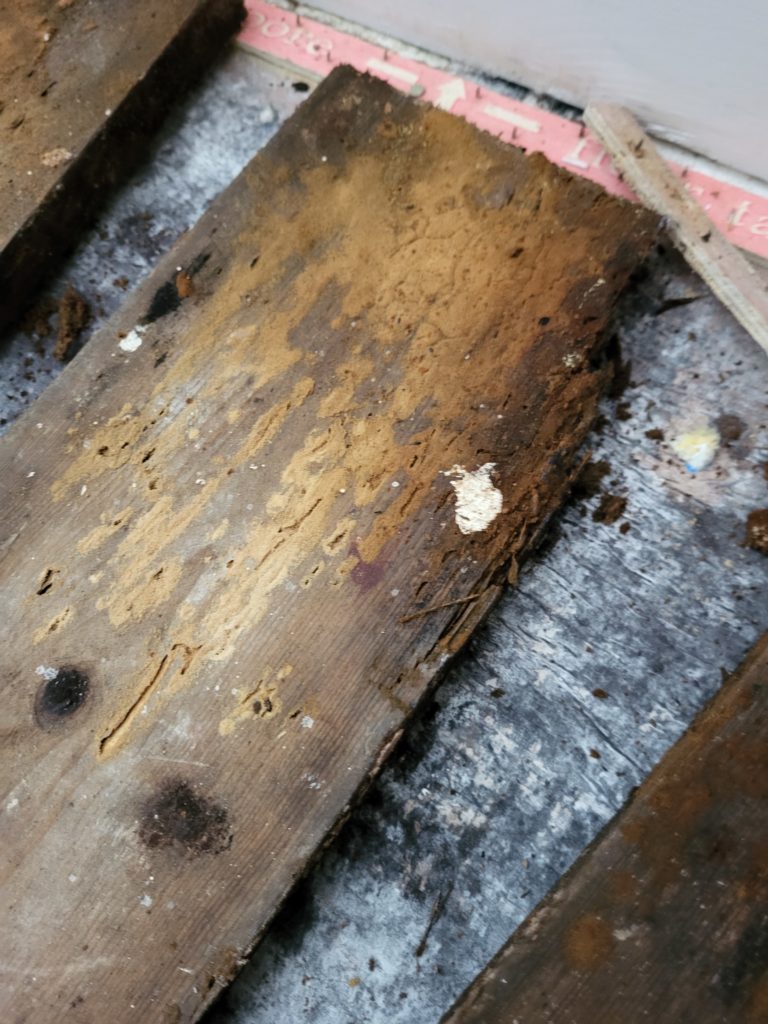
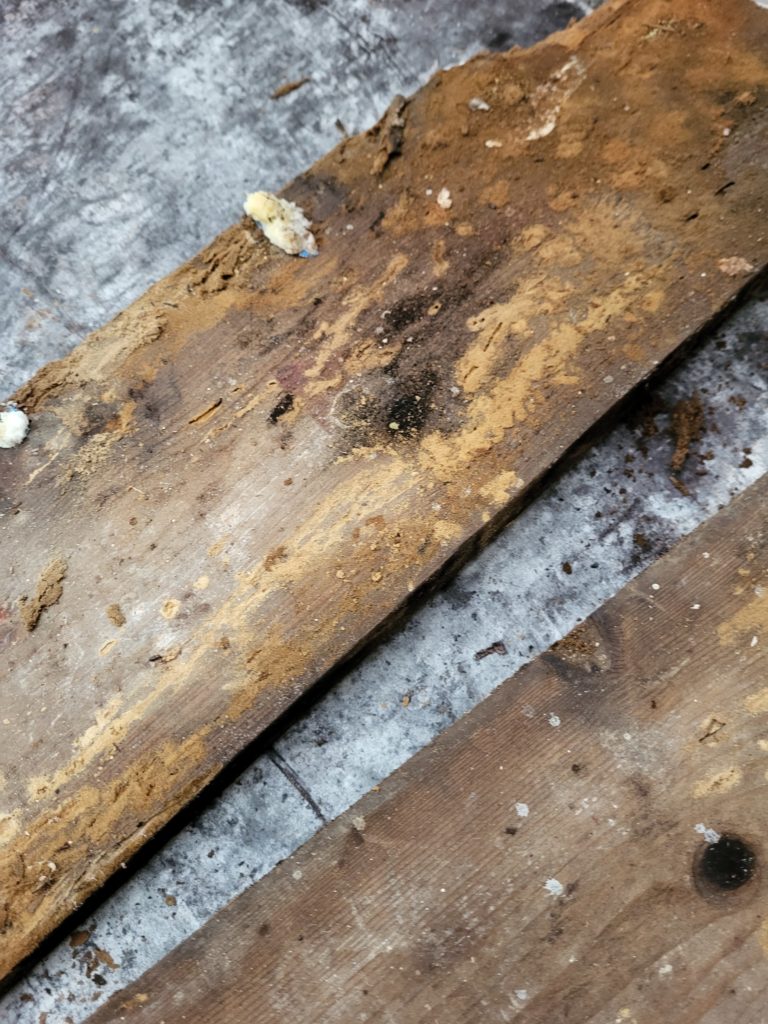
How can I prevent woodworm?
The key to this is the level of moisture in your timber. All woodworm larvae prefer higher moisture content, simply because it makes the wood easier to chew.
So, you should eliminate any damp patches in your home that will affect structural timbers of house furniture.
Furniture made from good, quality heartwood, is more resistant. Common furniture larvae only eat the outer sapwood, because of its nutrients.
It’s also toxin-free, unlike the inner heartwood of the pine and oak. Heartwood is usually heavier which give you a guide when buying your furniture.
The other risk to avoid is bringing woodworm into your house. Always check new antique purchases for any evidence of woodworm, and keep any stored firewood outdoors.
How is woodworm treated?
First, we establish the extent of the problem. A fully trained and experienced surveyor will inspect your home. You need a thorough woodworm survey to ensure treatment is necessary in the first place.
Once woodworm is confirmed, our surveyor will:
- Identify the type of beetle and the scale of the infestation
- Establish if the woodworm is active and which stage of its life cycle it is in
- Specify a treatment for your home
- Identify any other repairs required (e.g. for dry rot or damp if necessary)
Can I treat woodworm myself?
Your local DIY store will stock proprietary brands of woodworm killers.
If you’re absolutely confident your infestation is isolated to, for example, one small piece of furniture, using this can be an appropriate course of action, ensuring you follow the application instructions carefully.
If you want to treat woodworm yourself, of course, the chemicals are available on sale in a range of different outlets.
Be aware that using some of the available chemicals means you will need to observe COSHH regulations and you should ensure that you are adequately protected before you attempted any treatment.
However, there are many variables within woodworm problems, such as the type of beetle, the stage in its lifecycle, how active it is, how extensive it is and is it actually woodworm at all?
If you don’t know the answer to these questions, you could be wasting both your time and money with self-treatment and, worse, the woodworm could continue to eat your household timbers without you knowing it. What looks ‘treated’ might be anything but.
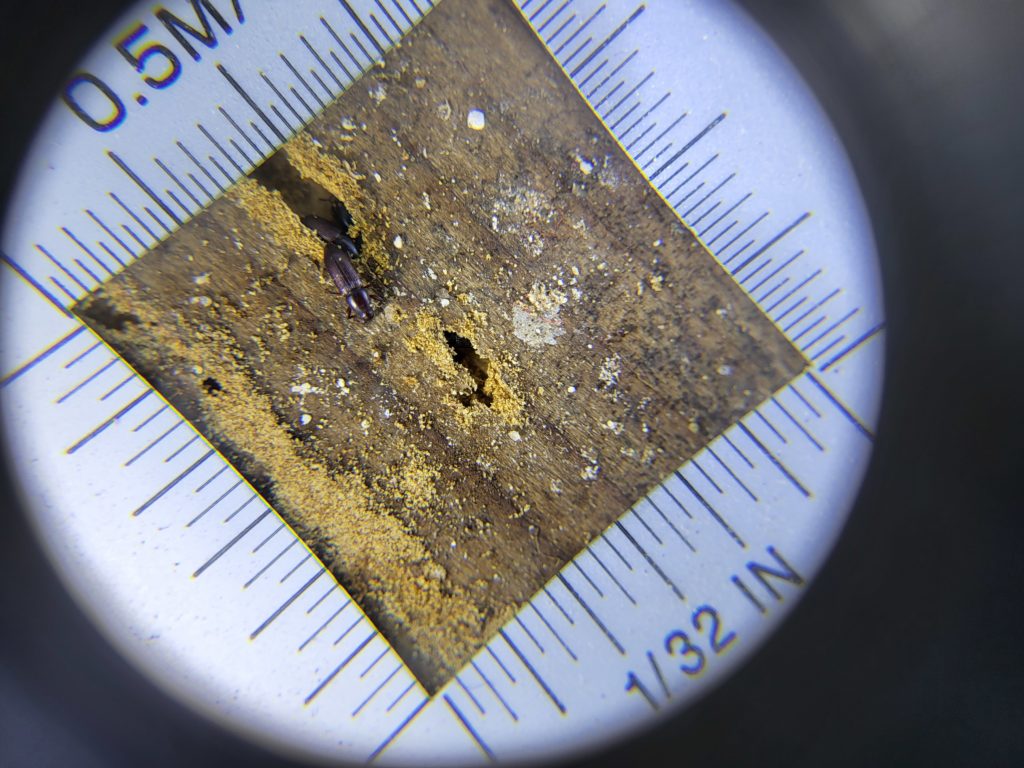
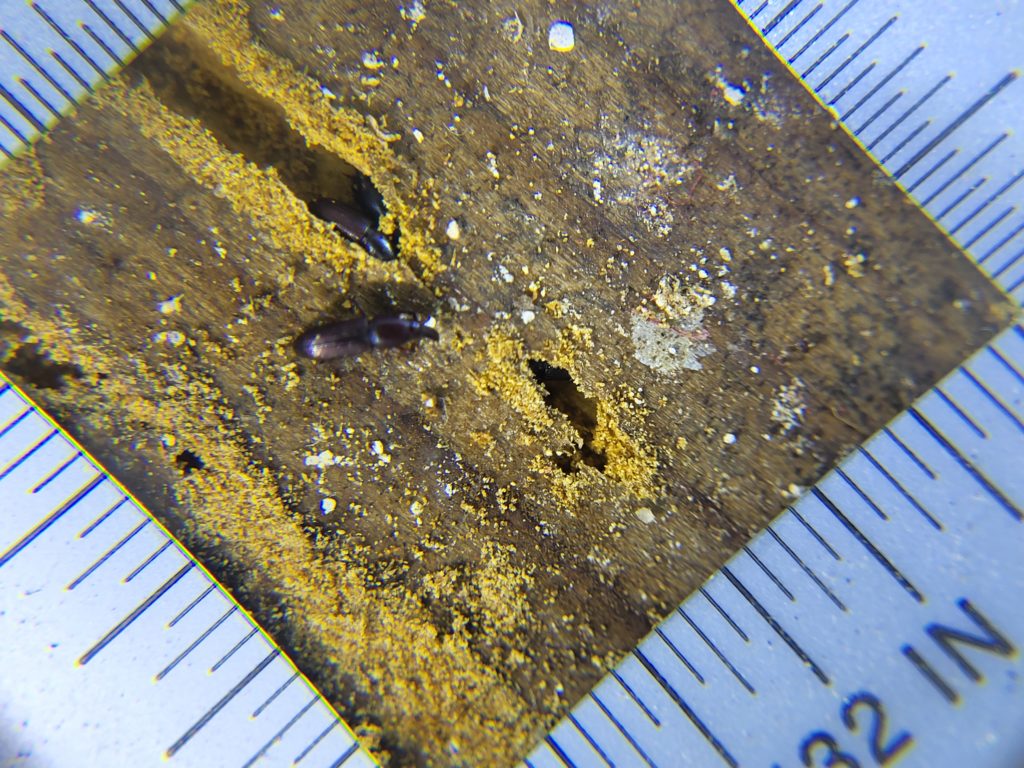
Does woodworm spread?
Woodworm isn’t infectious or contagious. If you place a ‘clean’ piece of timber next to one with woodworm, the infestation will not necessarily cross over.
For one thing, the new timber may not be to your resident beetles’ taste. However, that does not mean the woodworm cannot spread, particularly within the timber where it has originated.
After all, in choosing that wood, a beetle has found a good place to raise her young, with the right timber and conditions. So when the new adults emerge, why would they go anywhere else?
This can be a particular problem where the potential for widening out the infestation in a piece of wood from its starting point is substantial, for example, on a long roof beam.
How to tell if woodworm is active?
This is not always straightforward. One possible sign of fresh activity is the presence of frass around bore holes, particular where it might otherwise have been dispersed, if not renewed, (e.g. furniture legs in rooms that are used and cleaned).
This test is less helpful in confined areas such as in roof spaces and under floorboards, which can remain untouched for many years.
Another method is to plug an exit hole with beeswax or lay tissue paper over the timber to see if a new adult beetle bores through to escape the wood. However, you may have to wait up to a year to see any results.
Because it can be difficult to get a clear indication, this is why you really need a woodworm treatment specialist, if in doubt.
When do woodworm fly?
When a newly formed adult woodworm beetle bores out of the timber, they take to the air in search of a mate.
Adult males only have four days to achieve this before they die, so they will be quite active, often heading towards sources of light.
This ‘flight season’ lasts May – September and is a good time to spot woodworm beetles in your home.
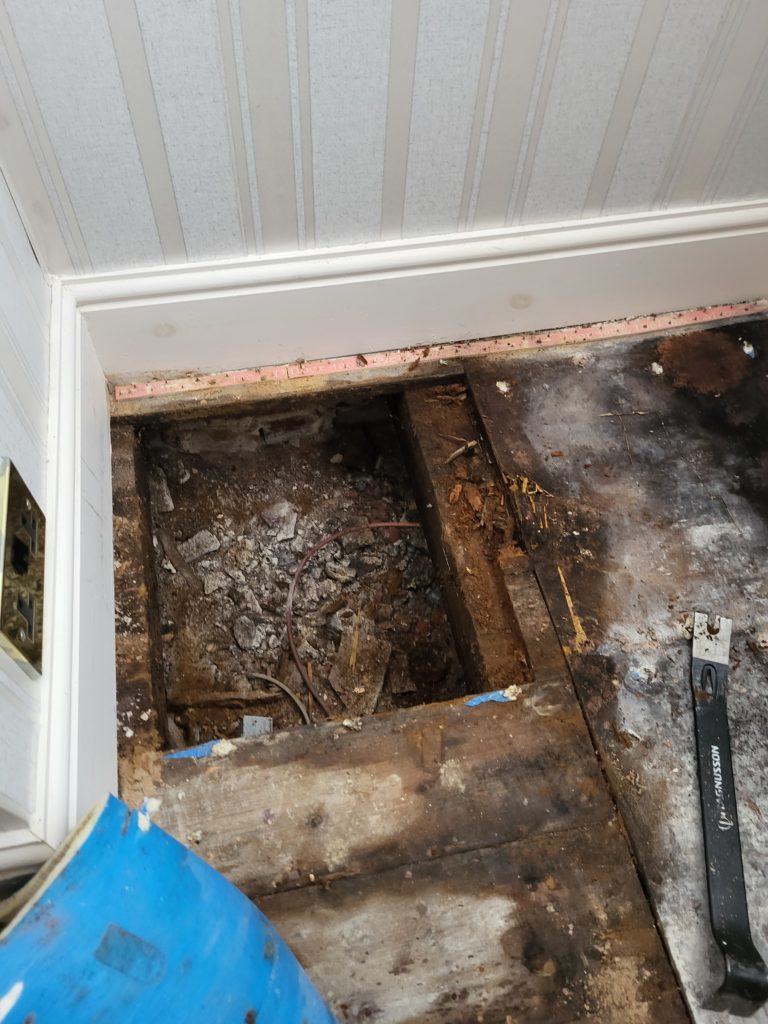
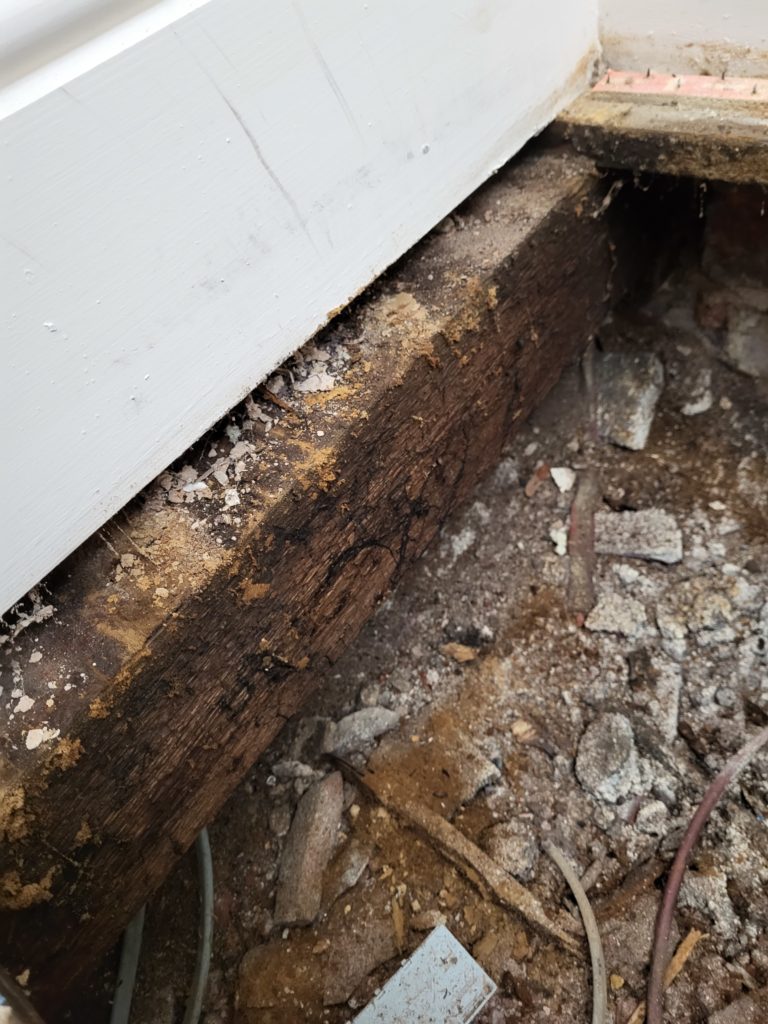
What is the cost of woodworm treatment?
In order to provide an accurate quotation, our woodworm specialist surveyors will need to carry out a full inspection to determine the best treatment for the property.
Cost of the treatment can depend on the damage caused and the size of the infestation.
Read our woodworm guide
Woodworm frequently asked questions:
How safe are woodworm treatment chemicals?
We are environmentally friendly and only use the safest chemicals available for the specific treatment. These include the latest and most effective 1 hour re-entry insecticides. All our products have virtually no odour and can be used whilst the property is still occupied.
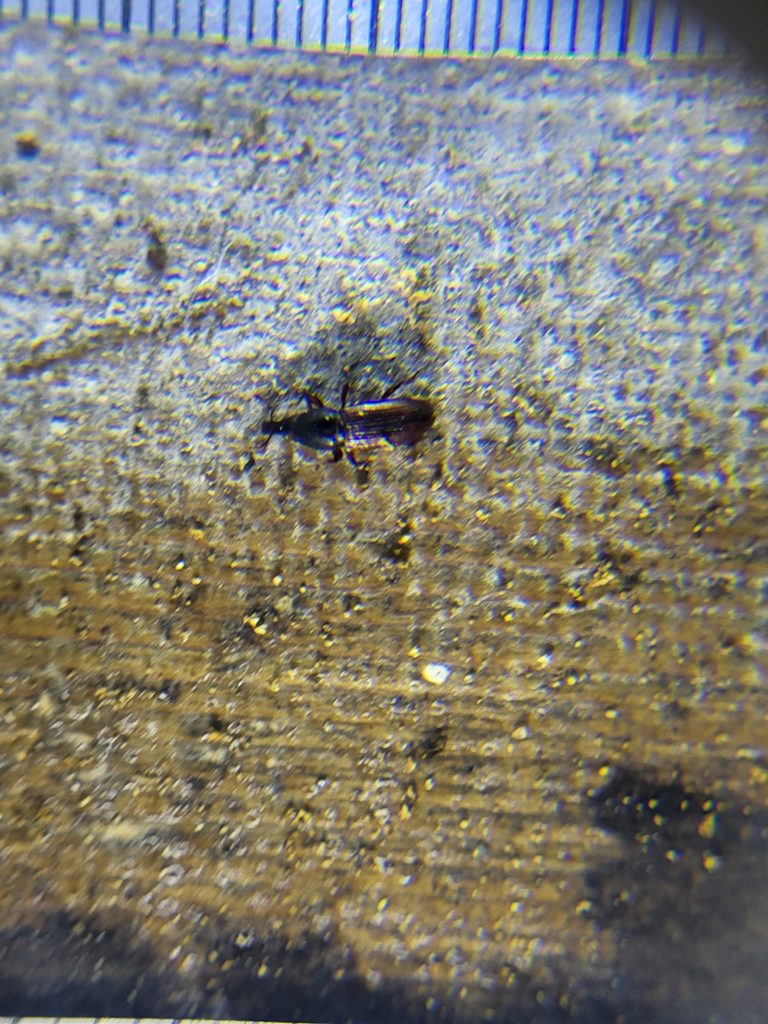
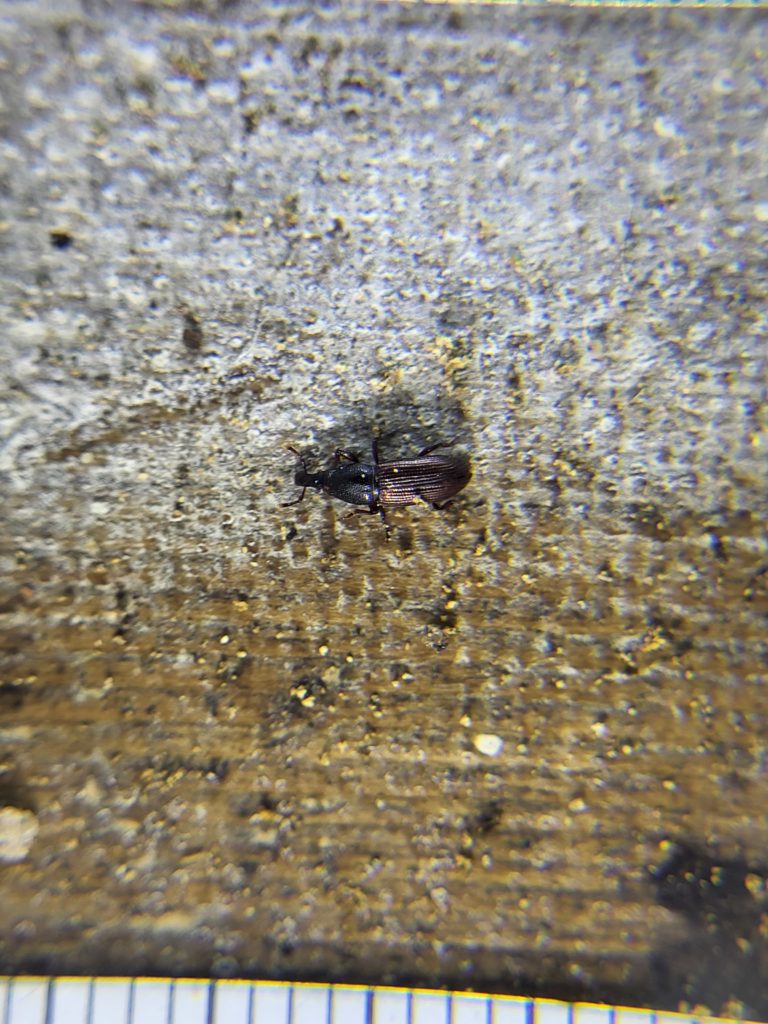
I have discovered a number of insects on the window sill in my house. Do I have woodworm?
It would not be possible to say for definite without seeing it, but, there are other tell tale signs you can look for in your property. For instance, holes in any of the structural timbers or any evidence of bore dust (small piles of bore dust, sometimes called ‘frass’), which is caused by adult woodworm beetles emerging from the timber.
If you are unsure, ask a fully qualified RTC woodworm surveyor to carry out a detailed inspection, so that the infestation can be dealt with promptly and effectively.
My property was already treated, but a few insects have appeared. Did treatment work?
Our treatment targets the young larvae buried within the timber and, as the life cycle of the insect is between 3 and 5 years in the case of the common furniture beetle, there can still be some woodworm beetles which have reached the adult stage emerging from the timber.
This is commonly called ‘post treatment emergence’. However, any eggs that may be laid in cracks, crevices or old flight holes, will not survive the treatment that has been applied to the timber, therefore, breaking the life cycle.
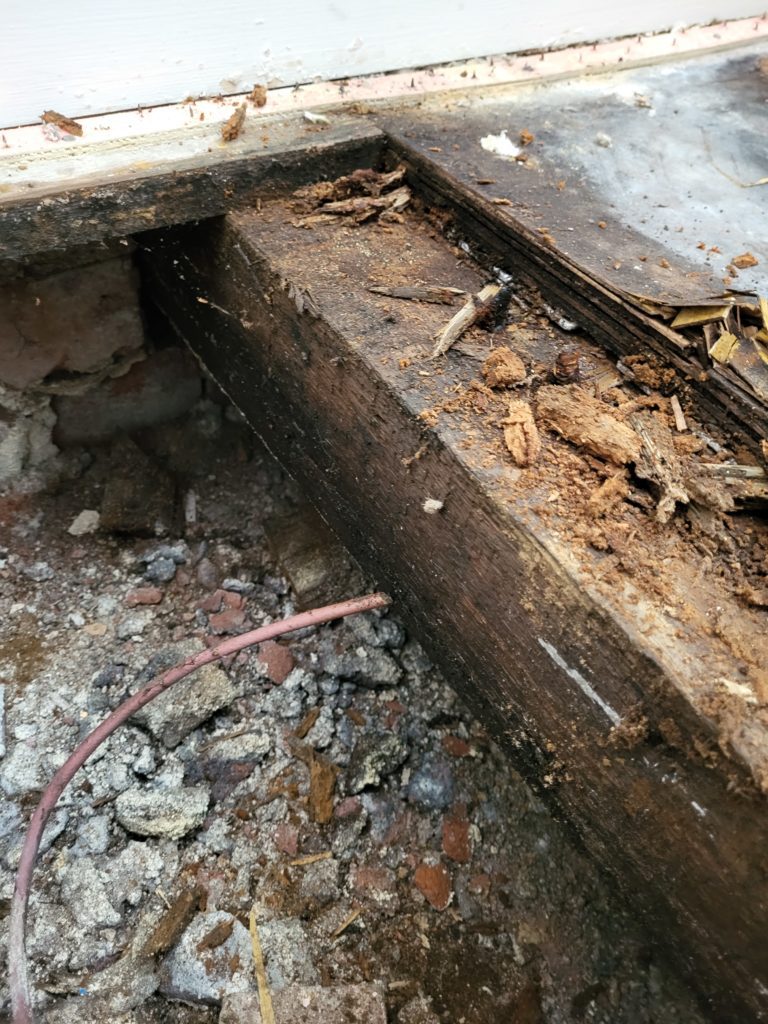
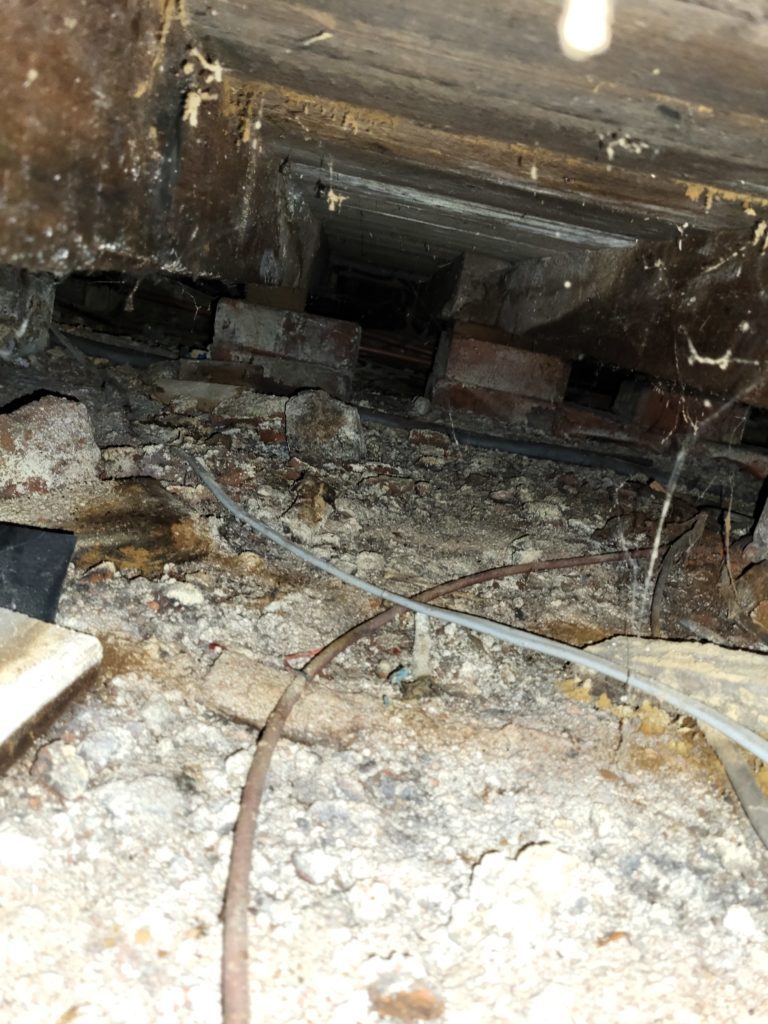
What guarantees do RTC offer?
RTC are Property Care Association (PCA) members, therefore, are able to offer the option of a long term insured guarantee for dry rot treatment issued by the QANW.
Because the QANW guarantee is genuine insurance, it provides protection if the contractor ceases to trade for any reason. It is also transferable to the new owners if you sell your property. See https://qanw.co.uk/ for more information.
For any queries on woodworm solutions, or to book a survey, please contact us.
Our staff will work closely with you from survey stage, right through to the successful completion of the contract.

